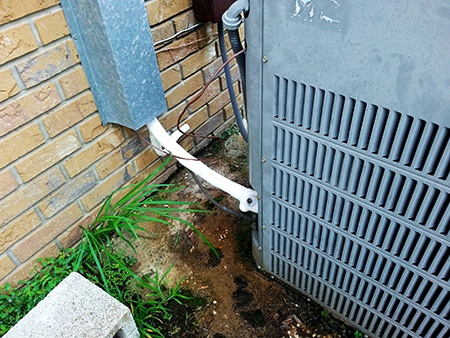Actions to Take When Your AC Pipe Freezes: Key Advice
Actions to Take When Your AC Pipe Freezes: Key Advice
Blog Article
Each person has got their own unique idea with regards to Have a Frozen AC Line? Here’s How to Fix It.

Intro
Uncovering that your AC pipe is frozen can be concerning, particularly throughout warm summer months when you depend on your ac unit the most. Understanding what to do in such a situation is vital to stop more damages to your air conditioning system and guarantee your convenience inside.
Recognizing the Causes
Numerous variables can add to the cold of an a/c pipeline. Comprehending these causes can help you address the concern successfully.
Absence of Airflow
One typical reason for a frozen a/c pipeline is inadequate air movement. When the air movement over the evaporator coil is limited, it can trigger the coil to go down below freezing temperature, bring about ice development on the pipe.
Reduced Refrigerant Levels
Inadequate cooling agent degrees in your air conditioning system can additionally result in an icy pipe. Reduced cooling agent levels can trigger the pressure in the system to drop, leading to the freezing of moisture on the evaporator coil.
Cold Weather Conditions
In colder environments, freezing temperatures outside can add to the cold of air conditioner pipelines. If your air conditioner unit is not effectively shielded or if there are leakages in the ductwork, cool air can penetrate the system, creating the pipeline to ice up.
Dirty Air Filters
Filthy or stopped up air filters can limit air flow in your air conditioning system, resulting in different issues, including an icy pipeline. It's vital to replace or clean your air filterings system routinely to guarantee proper airflow and prevent ice buildup.
Indicators of a Frozen A/c Pipe
Recognizing the indicators of a frozen air conditioner pipe is essential for punctual action.
Minimized Airflow
If you notice a substantial decrease in air movement from your vents, it could suggest an icy pipe.
Ice Buildup on the Pipe
Visible ice build-up on the refrigerant line or the evaporator coil is a clear indicator of a frozen air conditioner pipeline.
Weird Sounds from the Unit
Unusual sounds, such as hissing or gurgling, coming from your air conditioner device can indicate that there's ice existing on the pipe.
Immediate Actions to Take
When confronted with a frozen air conditioning pipeline, it's essential to act quickly to avoid additional damages to your air conditioning system.
Shutting off the air conditioner
The first step is to switch off your a/c to avoid the system from running and worsening the problem.
Checking for Blockages
Inspect the location around the interior system for any blockages that might be blocking airflow, such as furnishings or drapes.
Thawing the Pipe
You can make use of mild methods like positioning towels soaked in warm water around the icy pipe to aid thaw it slowly.
Safety nets
Taking preventive measures can help prevent future occurrences of an icy air conditioning pipeline.
Regular Maintenance Checks
Arrange regular maintenance checks with an expert HVAC technician to make sure that your air conditioner system is running effectively.
Transforming Air Filters
On a regular basis replace or clean your air filters to stop airflow constraints and preserve optimal efficiency.
Shielding Exposed Pipes
If your AC pipes are subjected to chilly temperatures, take into consideration insulating them to prevent freezing throughout cold weather.
Seeking Professional Help
If DIY approaches stop working to settle the issue or if you're not sure regarding exactly how to continue, it's finest to seek support from a qualified HVAC specialist.
When DIY Methods Fail
If your attempts to thaw the pipe or address various other problems are not successful, it's time to call an expert.
Significance of Hiring a Professional HVAC Technician
A licensed HVAC specialist has the competence and tools necessary to detect and repair problems with your AC system securely and efficiently.
Verdict
Taking care of a frozen air conditioner pipe can be a frustrating experience, but knowing exactly how to react can help decrease damage and recover comfort to your home. By recognizing the causes, acknowledging the indications, and taking timely activity, you can properly address the problem and protect against future occurrences.
G UP? HOW TO FIX IT?
It happens all over America. And the rest of the world probably. It’s the hottest day ever and for some darn reason your AC isn’t cooling the house. You fiddle with the thermostat to try and fix the problem. Nada. All you can do now is go outside and check the AC unit. You make your way there and find your air conditioner unit is frozen! But how?
In this post we’ll cover how you can tell that your air conditioner has frozen (other than the obvious reasons), what could have caused the freeze, and some of the things you can do about your AC freezing up. And if you have a frozen heat pump condenser, read our blog about it to learn what to do! But remember, it is always best to avoid your AC freezing up with an AC tune up. And if you are moving into a home, it's critical to get HVAC inspection so that you are aware of an AC problems before you move in.
Keep reading and you may be able to fix the frozen AC yourself. If you can’t, call an HVAC specialist. If you live in Maryland, call SuperTech HVAC for AC repair. We’ll take care of it.
How Does An Air Conditioning Unit Work?
How you probably imagine an AC works is wrong. Contrary to popular belief, an AC system does not inject cool air into a building. Instead, it removes the heat from inside and transfers it outside. Cool huh? (Pun intended).There are 4 major components among the 3 stations of an air conditioning system: the evaporator coil, the compressor, the condenser, and the refrigerant – a special chemical that links everything together through a closed loop system.
Station 1:
Warm indoor air is sucked into the return vent, through a filter, and blows over the evaporator coil. The heat is absorbed into the cold refrigerant, turning it from liquid to gas. The air, which is now cool, is blown back into the home to areas that your thermostat, i.e. you, has decided.
Station 2:
The refrigerant makes its way outside the house to the compressor, which squeezes the warm refrigerant, raising its gaseous temperature even more.
Station 3:
When the super hot vapor refrigerant reaches the condenser, the last step, the heat is expelled and absorbed into the outdoor air. The refrigerant instantly cools, which changes it from gas back to liquid form. The cold liquid refrigerant is now ready to return to station 1 and repeat the process.
Is Your AC Freezing Up? Here Are The Signs:
As you may have guessed, your air conditioner unit freezing up on a hot day is not normal.
If this happens, there's no need to panic. Often the issue can be solved with a little troubleshooting. If the AC unit is left frozen for too long however, you may find yourself with a bigger problem.
First things first, how do you know your AC is frozen?
Well, the obvious sign is the ice on your refrigerant line-set pipe. Simply check between your outdoor AC unit and your home's exterior wall to see whether your AC line frozen.
You might also have a frozen evaporator coil. This one's not as easy to check. You'll need to open a panel on the indoor unit to inspect. Don't do this unless you're handy. If you aren't, call an HVAC pro like SuperTech HVAC or you may damage something in the process.

I hope you enjoyed reading our section on Have a Frozen AC Line? Here’s How to Fix It. Thanks for taking a few minutes to read through our short article. Don't hesitate to take the time to promote this post if you enjoyed it. Thanks for taking the time to read it.
This Post Report this page